Complete Solutions to EXERCISE -4 of chapter CHEMICAL BONDING AND MOLECULAR STRUCTURE of Class 11 book with complete answers and questions
| Class 11 | CHEMISTRY |
| Chapter | CHEMICAL BONDING AND MOLECULAR STRUCTURE |
| NARAYANA | EXERCISE -4 |
| Number Of Questions | 54 |
| Academic Year | 2023-24 |
Among the following ions the p `pi`- d `pi` overlap could be present in
View SolutionNitrogen forms `N_(2)` but phosphorous when forms `P_(2)` gets readily converted into `P_(4)` because
View SolutionThe correct sequence of increasing covalent character is represented by
View SolutionWhich of the following will no give a precipate with `AgNO_3`?
View Solution`AlCl_3` anhydrous is covalent but `AlCl_3. 6H_2O` is ionic because
View SolutionThe correct stability order of the following resonance structures is
`(I)H_(2)C = overset(+)N = overset(-)N" "(II)H_(2)overset(+)C - N = overset(-)N`
`(III)H_(2)overset(-)C - overset(+)N = N" "(IV)H_(2)overset(-)C - N = overset(+)N`
View SolutionIn `PO_(4)^(3-)` ion the formal charge on the oxygen atom of P-O bond is
View SolutionArrange LiF, NaF, KF, RbF and CsF in order of increasing lattice energy.
View SolutionWhich of the following are arranged in the decreasing order of dipole moment ?
View SolutionThe dipole moment of
 is 1.5 D. The dipole moment of
is 1.5 D. The dipole moment of 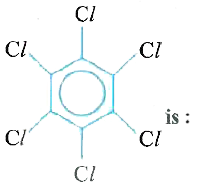 is:
is:
View SolutionThe bond angle in `H_2S` is
View SolutionIf H - X bond length is `2Å` and H - X has dipole moment `5.12 xx 10^(-30)` coloumb.calculate the % of covalent character of molecule is
View SolutionArrange the following compounds in order of increasing dipole moment .
Toluene `(I)` m-dichlorobenzene `(II)`
o-dichlorobenzene `(III)` . P-dichlorobenzene `(IV)` .
View SolutionWhich one of the following arrangements of molecules is correct on the basic of their dipole moments?
View SolutionWhich of the following molecule has highest bond energy ?
View SolutionIn `NO_(3)^(-)` ion, the number of bond pair and lone pair of electrons on nitrogen atom are:
View SolutionAmong the following the pair in which the two species are not isostructural is
View SolutionIn a regular octahedral molecule `MX_(6)` the number of `X - M - X` bonds at `180^(@)` is
View SolutionIn an octahedral structure , the pair of d orbitals involved in `d^(2)sp^(2)` hybridization is
View SolutionIn correct statement about the structure of `PCl_5`
View SolutionWhich statement is incorrect for `OSF_4` ?
View SolutionWhich of the following statement is/are true
1) `PH_5 and BiCl_5` donot exist
2) p - d bond is present in `SO_2`
3) `I_3^(+)` has geometry
4) `SeF_4 and CH_4` have same shape
View SolutionThe states of hybridisation of boron and oxygen atoms in boric acid `(H_3 BO_3)` are respecitivelty :
View SolutionThe d-orbital involved in `sp^3d` hybridisation is
View SolutionTrimethylamine is a pyramidal molecule
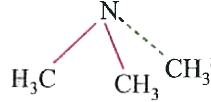 and formamide is a planar molecule
and formamide is a planar molecule 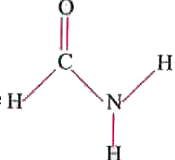 the hybridisation of Nitrogen in both is
the hybridisation of Nitrogen in both is
View SolutionWhich statement is correct about `HCHO` ?
View SolutionThe correct order of hybridization of the central atom in the following species `NH_3,[PtCl_(4)]^(2-),PCl_(5),` and `BCl_(3)` is
View SolutionSpecify the coordination geometry around and the hybridisation of `N` and `B` atoms in `1 : 1` complex of `BF_(3)` and `NH_(3)`.
View SolutionWhich of the following is paramagnetic ?
View SolutionThe least stable ion among the following is
View SolutionWhich of the following molecular orbital has two nodal planes perpendicular to each other?
View SolutionThe `O-O` bond length in `O_2, O_2 [AsF_4]` and `K [O_2]` is :
View SolutionKF combines with HF to form `KHF_(2).` The compound contains the species
View SolutionAmong the following mixiture dipole-dipole as the mojor interaction is present is
View SolutionThe nodal plane in the `pi`-bond of ethene is located in:
View SolutionIn the dichromate dianion,
View SolutionWhich of the following overlap is correct?
View SolutionThe values of electronegativity of atom A and B are 1.20 and 4.0 respectively. The percentage of ionic character of A-B bond is nearly
View SolutionIsostructrual species are those which have the same shape and hybridisation. Among the given identify the isostructural pairs.
View SolutionPolarity in a molecule and hence the dipole moment depends primarily on electronegativity of the constituent atoms and shape of a molecule. Which of the following has the highest dipole moment?
View SolutionHydrogen bonds are formed in many compounds e.g. `H_(2)O`, HF, `NH_(3)`. The boiling point of such compounds depends to a extent on the strength of hydrogen bond and the number of hydrogen bonds. The correct decreasing order of the boiling points above compounds is
View SolutionWhich molecule/ion out of the following does not contain unpaired electrons?
View SolutionIn which of the following molecule/ion, all the bonds are not equal?
View SolutionIn which of the following substances will hydrogen bond be strongest ?
View SolutionWhich of the following orderof energies of molecular orbitals of `N_(2)` is correct?
View SolutionWhich of the following statement is not correct from the view point of molecular orbital theory?
View SolutionWhich of the following statements are correct about `CO_(3)^(2-)`?
View SolutionWhich of the following statement is not correct ?
View SolutionWhich of the following molecular orbitals has two nodal planes ?
View SolutionMolecular axis is Z axis , then which of the following combination of orbitals will result in formation of `sigma` molecular orbitals ?
View SolutionMatch the species in Column I with the type of hybrid orbitals in Column II.
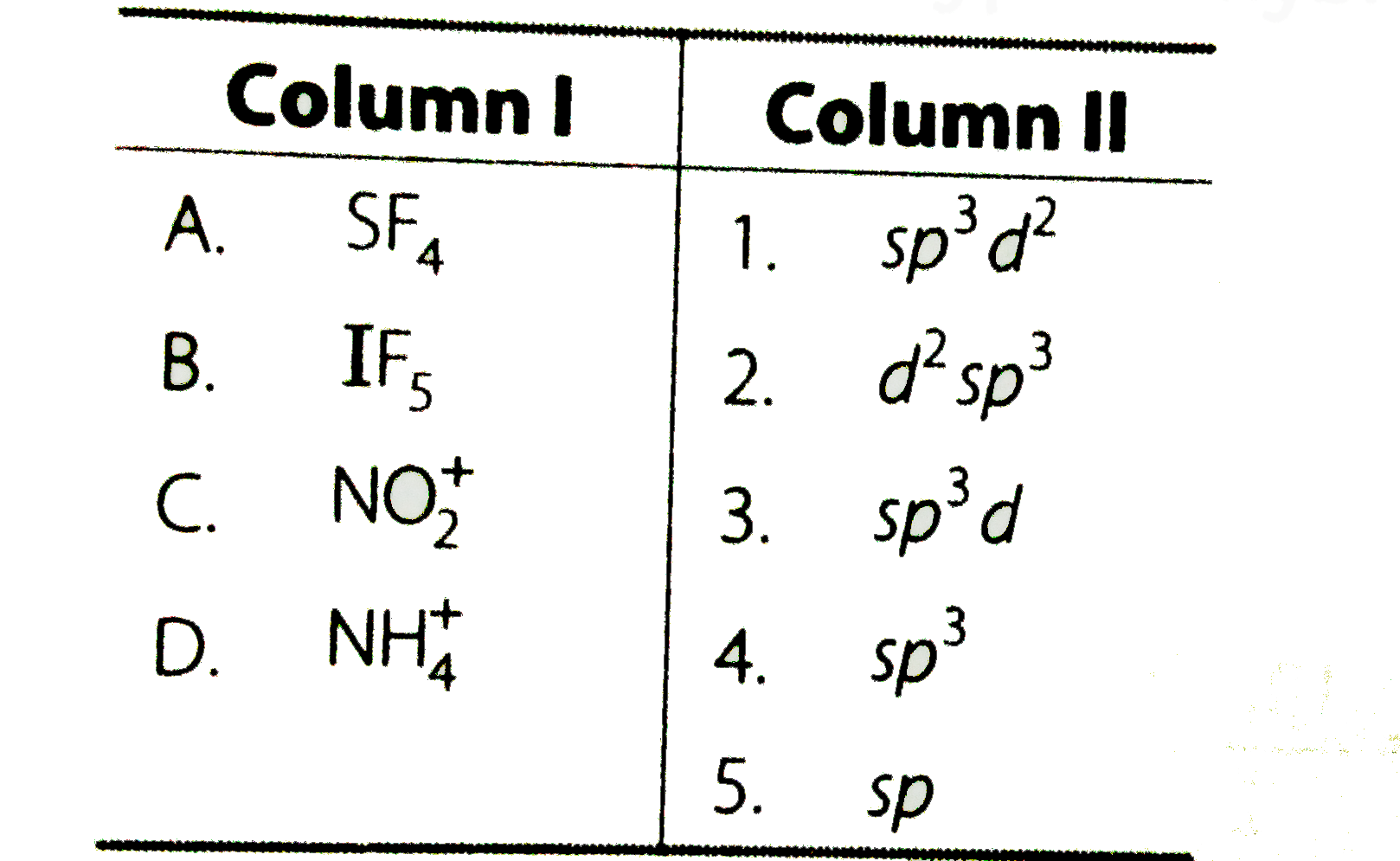
View SolutionMatch the species in Column I with the geometry/shape in Column II.

View SolutionMatch the species in Column I with the bond order in Column II.
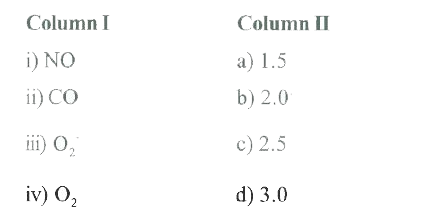
View SolutionMatch the items given in column i with example given in Column II
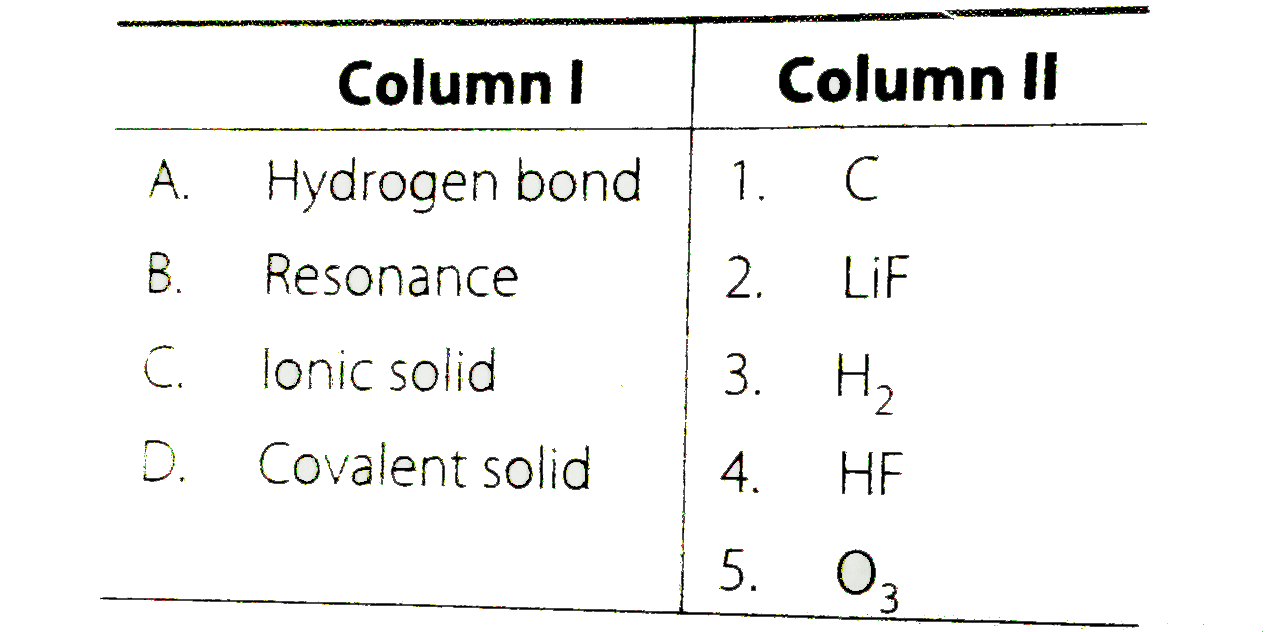
View Solution
EXERCISE -4 questions and complete solutions for chapter CHEMICAL BONDING AND MOLECULAR STRUCTURE of NARAYANA CHEMISTRY (HINGLISH) of Class 11
All Exercises from NARAYANA Class 11 CHEMISTRY CHEMICAL BONDING AND MOLECULAR STRUCTURE
- CHECK YOUR GRASP
- CUQ (BOND PARAMETERS)
- CUQ (DATIVE BOND)
- CUQ (FAJAN.S RULES)
- CUQ (HYBRIDISATION)
- CUQ (HYDROGEN BONDING)
- CUQ (INTERODUCTION, VALENCE AND FORMULA WRITING)
- CUQ (IONIC BOND AND LATTICE ENERGY)
- CUQ (KOSSEL LEWIS THRORY)
- CUQ (MOLECULAR ORBITAL THEORY)
- CUQ (POLARITY AND DIPOLE MOMENT)
- CUQ (RESONANCE AND FORMAL CHARGE)
- CUQ (VALENCE BOND THEORY)
- CUQ (VSEPR THEORY)
- EVALUATE YOUR SELF - 1
- EVALUATE YOUR SELF - 2
- EVALUATE YOUR SELF - 3
- EXAMPLE
- EXERCISE - II (H.W.) (BOND PARAMETERS)
- EXERCISE - II (H.W.) (BOND POLARITY AND DIPOLE MOMENT)
- EXERCISE - II (H.W.) (DATIVE BOND)
- EXERCISE - II (H.W.) (HYBRIDIZATION)
- EXERCISE - II (H.W.) (HYDROGEN BONDING)
- EXERCISE - II (H.W.) (IONIC BOND AND LATTICE ENERGY)
- EXERCISE - II (H.W.) (MOLECULAR ORBITAL THRORY)
- EXERCISE - II (H.W.) (OCTET RULE)
- EXERCISE - II (H.W.) (RESONANCE)
- EXERCISE - II (H.W.) (VALENCE BOND THEORY)
- EXERCISE - II (H.W.) (VSEPR THEORY)
- EXERCISE -3
- EXERCISE -4
- EXERCISE- I (C.W.) (BOND PARAMETERS)
- EXERCISE- I (C.W.) (COVALENT BOND)
- EXERCISE- I (C.W.) (DATIVE BOND)
- EXERCISE- I (C.W.) (FAJAN.S RULES)
- EXERCISE- I (C.W.) (HYBRIDISATION)
- EXERCISE- I (C.W.) (HYDROGEN BONDING)
- EXERCISE- I (C.W.) (IONIC BOND AND LATTICE ENERGY)
- EXERCISE- I (C.W.) (KOSSEL LEWIS THEORY AND OCTET RULE)
- EXERCISE- I (C.W.) (MOLECULAR ORBITAL THEORY)
- EXERCISE- I (C.W.) (POLARITY AND DIPOLE MOMENT)
- EXERCISE- I (C.W.) (VALENCE AND FORMULA WRITING)
- EXERCISE- I (C.W.) (VALENCE BOND THEORY)
- EXERCISE- I (C.W.) (VSEPR THEORY)
- EXERCISE- I (H.W.) (BOND PARAMETERS)
- EXERCISE- I (H.W.) (COVALENT BOND)
- EXERCISE- I (H.W.) (DATIVE BOND)
- EXERCISE- I (H.W.) (FAJAN.S RULES)
- EXERCISE- I (H.W.) (HYBRIDISATION)
- EXERCISE- I (H.W.) (HYDROGEN BOND)
- EXERCISE- I (H.W.) (IONIC BOND AND LATTICE ENERGY)
- EXERCISE- I (H.W.) (KOSSEL LEWIS THEORY AND OCTET RULE)
- EXERCISE- I (H.W.) (MOLECULAR ORBITAL THEROY)
- EXERCISE- I (H.W.) (POLARITY AND DIPOLE MOMENT)
- EXERCISE- I (H.W.) (VALENCE AND FORMULA WRITING)
- EXERCISE- I (H.W.) (VALENCE BOND THEORY)
- EXERCISE- I (H.W.) (VSEPR THEORY)
- EXERCISE- II (C.W.) (BOND PARAMETERS)
- EXERCISE- II (C.W.) (BOND POLARITY AND DIPOLE MOMENT)
- EXERCISE- II (C.W.) (DATIVE BOND)
- EXERCISE- II (C.W.) (HYBRIDISATION)
- EXERCISE- II (C.W.) (HYDROGEN BONDING)
- EXERCISE- II (C.W.) (IONIC BOND AND LATTICE ENERGY)
- EXERCISE- II (C.W.) (MOLECULAR ORBITAL THEORY)
- EXERCISE- II (C.W.) (OCTET RULE & FORMAL CHARGE)
- EXERCISE- II (C.W.) (RESONANCE)
- EXERCISE- II (C.W.) (VALENCE BOND THEORY)
- EXERCISE- II (C.W.) (VSEPR THEORY)